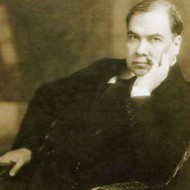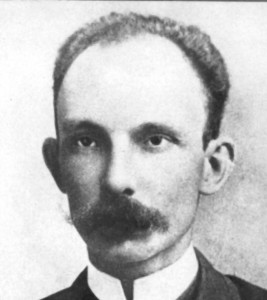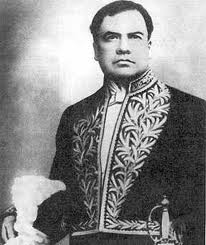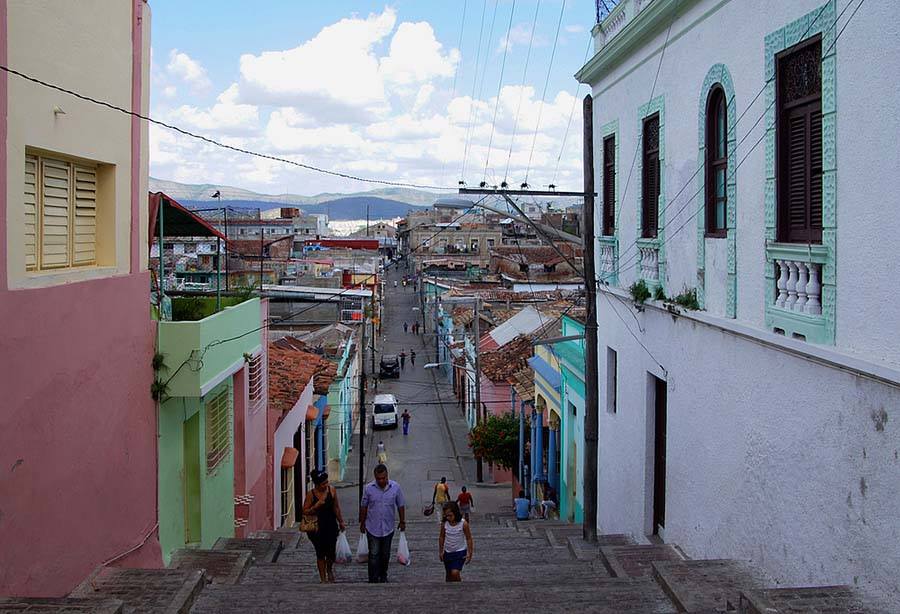José Martí preparaba la guerra necesaria desde el exilio mientras, en Cuba se vivía la tregua de una espera que los más avezados patriotas reconocían sería inevitable. Tranquila y reprimida se mantenía la capital el 27 de julio de 1892, al desembarcar del vapor México Rubén Darío. Llegaba en tránsito hacia España, como representante de Nicaragua, a los festejos por el cuarto centenario del descubrimiento de Colón de tierras americanas.
En la redacción del periódico El País se estrecharon las manos Rubén Darío y Julián del Casal, quienes se conocían -gracias al correo- desde 1887, a través de las páginas de la revista La Habana Elegante, que el poeta nicaragüense recibía con cierta frecuencia y en la que aparecieran trabajos de ambos.
El Fígaro ofreció un banquete a Darío, al cual asistieron Casal, Enrique Hernández Miyares (que en el número del 31 de julio de 1887 publicara un artículo sobre Darío en La Habana Elegante), Manuel Serafín Pichardo y otros. Uno de los comensales de aquel mediodía, Raoul Cay -redactor de El Fígaro- cuenta que «Casal apenas almorzó, la admiración que siente por Rubén y el regocijo de tenerlo cerca, quitaron el apetito al sombrío poeta de “Nieve” ».
Los días habaneros de Darío transcurrieron en continuos paseos, tertulias, agasajos y correrías. Al partir, en la tarde del 30 de julio, dejaba una estela de encanto entre la intelectualidad cubana.
El 5 de diciembre de aquel mismo año, de regreso a España en el buque Alfonso XIII, Darío hizo otra escala, de solo unas horas, pues al día siguiente embarcó en el México, el mismo que lo trajo la primera vez. Aprovechó para dejar algunos textos inéditos en la redacción de El Fígaro.
En 1893, en Nueva York, Darío es presentado a José Martí, por quien siente profundo respeto. Martí tuvo la gentileza de invitarlo a la velada que se celebró en Hardman Hall, donde él hablaría. Al escucharlo, se acrecienta la admiración de Darío hacia el pensador y político cubano.
Cabe leer lo que escribiera Darío del emotivo y único encuentro sostenido con Martí en Nueva York en su Autobiografía con el que ‟escribía una prosa profusa, llena de vitalidad y de color, de plasticidad y de música”; Pasamos por un pasadizo sombrío; y, de pronto, en un cuarto lleno de luz, me encontré entre los brazos de un hombre pequeño de cuerpo, rostro de iluminado, voz dulce y dominadora al mismo tiempo y que me decía esta única palabra: ¡hijo! Las distancias quedaron guardadas para siempre y Darío con nobleza y humildad reconocería el liderazgo del poeta y revolucionario cubano.
Siguiendo el ejemplo de José Martí (1852-1895), otro poeta modernista (quien también dirigió el movimiento de liberación nacional en Cuba contra el colonialismo occidental), Darío textos modernistas entretejió con referencias temáticas a anti-imperialismo y la armonía racial solamente posible en un futuro post-colonial. Un ejemplar y todavía no muy conocido poema en ese orden de ideas se encuentra en Darío Cantos de vida y esperanza (1905), en un artículo titulado “A Roosevelt”. En ella, él desafió a Estados Unidos, como “El Futuro invasor de la América ingenua Que TIENE sangre indígena” (“el futuro invasor de la América ingenua la que tiene sangre indígena”). Como tal, el coloso del Norte, con su fusión cínica del culto de Hércules y el culto al dinero, fue contrastada críticamente con las otras Américas, “la América nuestra, Que tenia poetas / desde l os viejos Tiempos de Netzahualcoyotol”.
Martí escribía en el prestigioso diario bonaerense desde 1882, fecha en que Bartolito Mitre lo incorporó como corresponsal, fue en las páginas de La Nación donde Darío comenzó a degustar del lirismo de la prosa martiana y donde tambien iniciara el culto, pasión y devoción por la figura del poeta cubano.
Meses antes de la muerte del poeta cubano, Darío publica ‟La insurrección en Cuba”, donde exalta los valores patrióticos, revolucionarios y el alto quilataje moral y estético del que, con sus encendidos discursos hacía centellear los ojos, fruncir los labios y crujir el corazón, ‟ Es el escritor amazónico… el escritor más rico en lengua española, es el Vanderbilt de nuestras letras”. Antes, en 1892 le había dedicado ‟La risa” a José Martí.
En la necrológica, bajo el título de José Martí no es el Padre quien recrimina al hijo, sino el hijo, puesto que así lo llamó Martí, quien recrimina al Padre: ‟Y ahora, maestro y autor y amigo, perdona que te guardemos rencor los que te amábamos y admirábamos, por haber ido a exponer el tesoro de tu talento…Cuba quizá tarde en cumplir contigo como debe. La juventud americana te saluda y te llora; pero, ¡oh maestro, qué has hecho! Se hace interesante puntualizar el reclamo que le hace Rubén al poeta muerto quien como rey mago se dejó arrastrar por la estrella engañosa hacia la más negra muerte, porque aquí es donde sobrepone Darío al Arte sobre la patria, y donde según Susana Zanetti se encuentran fuertes vínculos con el retrato que hace Darío de Ibsen, el visionario de la nieve, y también a mi juicio donde Darío asume el Yo-Poético, producto de su propia vivencia personal. ‟ su patria, como todas las patrias, fue una espesa comadre que dio de escobazos a su profeta” (Ibsen, Los Raros).
En 1911, Darío, para saldar deudas, realiza un análisis extenso a la obra de Martí, uno de los más extenso dedicado a un poeta, cuatro largos ensayos son enviados a La Nación bajo el Título los primeros tres de ‟José Martí, Poeta” los cuales se publican el 29 de Mayo, 3 y 10 de Junio, y el cuarto ensayo bajo el nombre de ‟Versos libres” que se publica el 8 de julio, en ellos hace un análisis completo, cuidadoso y riguroso de una y cada una de las obras, sus versos y prosas, hasta sus prólogos, puntualizando, criticando, reflexionado y certificando la calidad de la rica producción literaria de Martí, para terminar reconociendo que no fue él quien aportó el plasma germinal del cisne modernista ni los granos celestes de su doctrina: ‟A aquel Arcángel de coraza de acero, se le vieron en ese tiempo, en Nueva York y en Washington alas de cisne”.
Regresa a Cuba
Atrás ha quedado la segunda intervención norteamericana en Cuba. El Partido Liberal gana las elecciones y José Miguel Gómez ocupa la presidencia desde el 28 de enero de 1909. Su gobierno se hizo célebre por entronizar algunas costumbres: la lotería nacional, la lidia de gallos y los negocios de dudoso carácter.
Este es el panorama prevaleciente el 2 de septiembre de 1910, cuando Darío visita La Habana por tercera vez. Acuden a recibirlo don Ramón Catalá, de El Fígaro; Max Henríquez Ureña, escritor dominicano; Eduardo Sánchez de Fuentes, autor de la inmortal habanera Tú, entre otros. Un periodista de La Discusión obtiene el siguiente autógrafo: “Paz y progreso y gloria a Cuba, país que admiro y que he amado siempre. Rubén Darío”.
Durante su brevísima estancia, visita al patriota Manuel Sanguily y conoce al periodista Márquez Sterling. Los círculos intelectuales se disputan las horas de Darío. Al anochecer se le ofrece un banquete en el hotel Inglaterra y al día siguiente parte rumbo a México.
Para sorpresa de sus admiradores, Darío está de nuevo, el día 4, de regreso a La Habana, pues llega apenas hasta Veracruz y retorna en el mismo barco que le condujera a México.
Permanece en la capital cubana, deprimido y con poca salud, hasta el 8 de noviembre, cuando embarca con destino al Havre, en el vapor Ipiranga, de bandera alemana. Durante este lapso el poeta se alojó en el hotel Sevilla y luego en una pensión de El Vedado. Asistió al acto celebrado el 21 de octubre ante la tumba de Casal, ocasión en que leyó sentidas palabras.
CubaLiteraria/Depestre/Amaya/
InternetPhotos/www.TheCubanHistory.com
Rubén Dario,Jose Marti y Cuba.
The Cuban History, Hollywood.
Arnoldo Varona, Editor
RUBEN DARIO,JOSE MARTI AND CUBA.
José Martí is preparing the necessary war while in exile, in Cuba lived the truce the the most experienced patriots were waiting recognizing would be inevitable. Quiet and force to be quiet remained the capital when in July 27, 1892, landing coming in the steam ship ‘Mexico’ Ruben Dario. He arrived in transit to Spain , as a representative of Nicaragua , to the celebrations for the fourth centenary of the discovery of Columbus American lands .
In the newspaper El Pais Dario shook hands and Julian del Casal , who knew , thanks to e – since 1887 , through the pages of the magazine La Habana Elegante , a Nicaraguan poet received frequently and which appeared in the work of both.
The Figaro Darius gave a banquet , attended by Casal , Enrique Hernandez Miyares ( in the number of July 31, 1887 published an article about Darius in La Habana Elegante ) , Serafin Manuel Pichardo and others. One of the guests at that noon , Raoul Cay -editor of Le Figaro , that ” Casal just had lunch , the admiration for Ruben and the joy of having him around , took the gloomy poet appetite ” Snow ” “.
The days spent in Havana continuous Darius walks , talks , entertainment and raids. Upon leaving, on the afternoon of July 30 , leaving a trail of charm among Cuban intellectuals .
On December 5 of that year , back to Spain on the ship Alfonso XIII , Darius had another scale of a few hours , because the next day embarked in Mexico , the same that brought you the first time. He used to leave some unpublished texts in the writing of the Figaro.
In 1893 , in New York , Dario is presented to José Martí , for whom he feels deep respect . Marti was kind enough to invite to the evening which was held at Hardman Hall, where he would speak . Listening to him , it increases the admiration of Darius to the Cuban political thinker .
It should read what I write Dario ‘s emotional and sustained only meeting in New York Martí in his Autobiography with which ” profuse writing prose , full of vitality and color, plasticity and music ” ; went through a gloomy passage , and suddenly , in a room full of light, I found myself in the arms of a man small of body, face glow , sweet voice and dominating at the same time and telling me this one word :son! The distances were kept forever and Dario nobly and humbly acknowledge the leadership of the Cuban revolutionary and poet .
Following the example of José Martí (1852-1895) , another modernist poet ( who also directed the national liberation movement in Cuba against Western colonialism ) , Dario wove modernist texts with thematic references to anti -imperialism and racial harmony only possible in post -colonial future . An exemplary and not yet well-known poem in this vein is Darius ‘Songs of Life and Hope’ ( 1905 ) , in an article entitled ” A Roosevelt ” . In it, he challenged the United States as “The Future invasive naive American Indian blood I HAVE ” (“the future invader of the naive America that has Indian blood ” ) . As such, the Colossus of the North , with its fusion cynical cult of Hercules and the worship of money , was critically contrasted with the other Americas , ” our America , which had poets / from the Netzahual coyotol old times .”
Martí wrote in the prestigious Buenos Aires newspaper since 1882 , when it joined Mitre Bartolito as a correspondent , was in the pages of The Nation where Darius began to enjoy the lyricism of the prose also began Marti and where worship, passion and devotion Cuban poet figure .
Months before the death of Cuban poet , Darío published ” The insurrection in Cuba ” , which exalts the values of patriotism , revolutionary and high moral and aesthetic carats , with their fiery speeches made eye blinking , puckering and crunching heart, ” Amazon is the writer … the richest writer in Spanish, is the Vanderbilt of our letters.” Earlier in 1892 he had dedicated “Laughter ” José Martí .
In the notice , under the title of José Martí is not the Father who complains that the son, but the son , since you called Marti, who complains that the Father : ” And now , teacher and author and friend , sorry to keep you grudge the ones you loved and admired , for going to expose the treasure of your talent … Cuba perhaps meet with you later on as it should . American youth greets you and cries , but ,oh master , what have you done ! It is interesting to point the claim that makes the poet Rubén dead magician who as king was carried away by the star misleading to the blackest death , because this is where the Art Darius superimposed on the country, and where according Susana Zanetti are strong links with the portrayal of Ibsen Darius , the visionary of the snow, and in my opinion where Darius I – Poetry takes a product of their own personal experience. ” Their country, as all lands , was a thick broom godmother who gave his prophet ” ( Ibsen , The Rare ) .
In 1911 , Darius, to settle debts , makes a comprehensive analysis of the work of Martí , one of the most extensive dedicated to a poet , four long essays are sent to The Nation under the title the first three of ” José Martí , Poet ” which was published on May 29 , 3 and June 10 , and the fourth trial under the name of ” free Verses ” published July 8 in them makes a complete analysis , careful and rigorous one and each of works, his poetry and prose , to his prefaces , pointing , criticizing , reflected and certifying the quality of the rich literary production of Martí , finally recognizing that it was he who provided the modernist swan germplasm or celestial grains his doctrine : “Whoever Archangel steel armor , he saw at that time, in New York and Washington swan wings .”
Return to Cuba
Gone is the second American intervention in Cuba . The Liberal Party won the elections , and José Miguel Gómez took the chair from the January 28, 1909 . His government was famously enthrone some customs : the national lottery, the cockfighting business and doubtful character.
This is the situation prevailing on September 2, 1910 , when Darius visit Havana for the third time . They come to receive Don Ramon Catala , El Figaro , Max Henríquez Ureña , Dominican writer , Eduardo Sánchez de Fuentes, author of the immortal habanera Tú , among others. A reporter for The Talk get the following autograph : ” Peace and progress and glory to Cuba , a country that I admire and I have always loved . Ruben Dario ” .
During his brief stay, visit and meet Sanguily patriot Manuel Márquez Sterling journalist . Intellectual circles vie Dario hours . In the evening a banquet is offered at the hotel the following day England and leaves for Mexico .
To the surprise of her admirers , Darius is back , day 4 , returning to Havana , it comes just to Veracruz and returns in the same boat that would lead him to Mexico .
Stay in the Cuban capital , depressed and in poor health , until November 8 , when bound to Havre embarks on steam Ipiranga , German flag . During this period the poet stayed at the Hotel Sevilla and then a board of El Vedado . He attended the ceremony held on October 21 at the tomb of Casal , at which read heartfelt words .
CubaLiteraria/Depestre/Amaya/
InternetPhotos/www.TheCubanHistory.com
Rubén Dario,Jose Marti y Cuba.
The Cuban History, Hollywood.
Arnoldo Varona, Editor



 RUBEN DARIO, José Martí y Cuba (Fotos) * * RUBEN DARIO, José Martí and Cuba (Photos).
RUBEN DARIO, José Martí y Cuba (Fotos) * * RUBEN DARIO, José Martí and Cuba (Photos).


